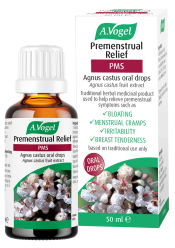Why do I experience period cramps?
Sometimes women just feel as if they have got the raw end of the deal, and cramps do nothing to alleviate the misery which accompanies your monthly period. Each month your body prepares an egg to be fertilised.
When this does not happen, the lining of your uterus is expelled. In order to do this, the uterus contracts, and it is these muscular contractions that cause menstrual cramps. Cramps are usually at their worst just before or at the beginning of your period, as this is when uterine contractions are strongest.

Can PMS cramps begin a week before my period?
It makes sense, then, for cramps to begin right at the start of your period, but they can also occur much earlier than this, one, or even two weeks before menstruation. There are a couple of reasons why this may be:
1. Throughout the month, your hormone levels are fluctuating, and of particular relevance are the female hormones oestrogen and progesterone. Changes in these hormones help your body to prepare for menstruation. However, sometimes, your body is somewhat over-enthusiastic in its preparation and begins uterine contractions too early, meaning that you experience cramps relatively early.
2. Some women are more sensitive to changes in their body, and can feel the egg being released each month. For some, this may not be a painful sensation, more a peculiar one; for others, this can feel very similar to typical period pain. Whatever the sensation, it will be felt on alternating sides each month as the egg is generally released from one ovary one month, then the other the next. For this reason, some women experience bi-monthly symptoms as each ovary can produce a different sensation.
What can I do to ease the pain?
The stoical woman often grins and bears the monthly cramp, knowing that it will not last too long and will be a whole month before she needs to bear the burden again. However, it need not be this way.
It makes sense that if the pain is caused by muscular contractions then relaxing the muscle will reduce the symptoms. This can be in the same way that you would treat cramping muscles in your leg or arm, for example.
There are many tips and tricks to try which should hopefully make this monthly nightmare a distant (or less painful) memory:
1. Agnus castus – this herb has a long traditional use in relieving premenstrual symptoms, including menstrual cramps. It is thought to help balance the female hormones, thus improving all aspects of the monthly period. It can be found in A.Vogel Agnus castus oral drops.
2. Heat therapy – warmth on your tender tummy, such as from a hot water bottle, is a great way of reducing cramps, relaxing the uterine muscles and easing pain.
3. Exercise – although you may not feel very much like getting out and about, even a little gentle exercise, such as going for a walk, can help to stretch out your muscles and reduce symptoms of cramps.
4. Painkillers – many women resort to conventional painkillers, including paracetemol and ibuprofen, for PMS cramps. However, if you can find an effective natural treatment, this is generally better for your overall health and wellbeing.
5. Magnesium – this important mineral is often forgotten in the battle with PMS cramps. However, it is extremely good for relaxing muscles and reducing inflammation. It is also thought to act as a painkiller.
Many women find that their cramps get better as they age. This is often because their periods regulate and becomes slightly lighter.
In particular, many women report that after childbirth, they no longer experience PMS cramps, or other symptoms of PMS. It is thought that this is linked to changed hormone levels after pregnancy (although we’re not suggesting childbirth as an option to reduce PMS!)
Could PMS cramps a week before my period be a sign of something more serious?
PMS cramps are extremely common, and something most women will be able to relate to – for some the pain is mild, for others it is severe; for some the pain can come and go, for others there is little let-up.
However, in a few cases, these cramps may be an indication of a more serious condition, most commonly a disorder in reproductive organs, including:
- Endometriosis – this is when the uterine tissue is found outside of the uterus
- Narrowing of the cervix
- Fibroids (non-cancerous growths) on the inner wall of the uterus
- Bacterial infection, such as pelvic inflammatory disease.
Generally speaking, the pain associated with these types of conditions is much more severe than normal PMS cramps.
Additionally, the pain lasts for much longer either side of the period, which makes many women fearful that cramps beginning a week before the period is an indication of a more serious condition.
It is important not to panic and think the worst, but if you do suspect a disorder of this kind, it is important to get it checked by a doctor or gynaecologist, as only with the correct diagnosis, can an appropriate treatment be found.
How do you ease PMS cramps? Have you got any tips and advice you’d like to share in the comment section below?









